Abstract
For thousands of years, the volcanic activity present along the Andes Mountain range has generated a large amount of pyroclastic material. As a result, around 60 percent of the soils present in Chile have a volcanic origin, of which, we can find soils derived from volcanic ash. These correspond to soils whose origin is the weathering of volcanic ash, which generates minerals such as allophane, imogolite, and halloysite. The presence of these minerals gives these soils unique geotechnical properties, such as high plasticity, low dry unit weight, and a unique internal structure. Subjecting these soils to extreme temperatures like those needed to perform standard laboratory tests produces changes in their structures, and thus in their geotechnical behavior. These changes are important to be aware of with respect to slope stability problems, embankment conformation, surface foundations, etc. In the present study, a type of soil found in Chile originating from the weathering of volcanic ash and locally named Trumao was studied. Due to its age and formation processes, the main minerals found in the soil are allophane and imogolite, and hence it belongs to the allophanic soil type. The material was studied in its natural state (undisturbed) and, after being oven-dried using common geotechnical tests, the behaviors of both samples were compared. The study shows that some properties are affected significantly by the oven-drying process, and thus it is not recommended to expose the material to high temperatures during geotechnical laboratory testing to avoid misleading results.
1. Introduction
Chile is characterized by an extensive chain of active volcanos that have erupted over a long period of time a large volume of explosive pyroclastic material ranging in size from bombs, lapilli to fine volcanic ash. The latter is transported by wind and deposited over large areas. The volcanic ash is composed of silicate minerals and volcanic glass, which, over time and weathering, form new minerals, giving rise to a type of residual soil derived from this volcanic ash [1]. In Chile, one of the soils derived from volcanic ash has the local name Trumao. According to Schlatter et al. [2] and Veblen [3], Trumao is a type of allophanic soil of the Andosol order found in central and southern Chile, formed from young volcanic ash or volcanic ash redeposited by aeolian or mobilized by alluvial processes. Most of these soils occur near the Andes Mountain range, specifically within the foothills geomorphological unit [4]. Wright [5] discussed the existence of different types of Trumao, classified according to the zone where they are located, and differentiating each depending on the morphology, chemistry, genesis, and classification. Based on the above, the Trumao of this investigation corresponds to the northern area, presenting an annual rainfall between 1100 and 2500 mm and maximum temperatures that oscillate between 26 and 28 °C.
In general, the geotechnical properties of soils derived from allophanic volcanic ash can be correlated to a variation in the temperature during the formation process and the internal structure of the soils [6]. Trumao changes the internal structure of its particles when exposed to high temperatures. For example, in preparing soils for geotechnical laboratory tests, in most cases, the samples achieve temperatures above 100 °C. Therefore, the preparation process could change the original structure, mechanical behavior, and physical characteristics of some soils. Thus, caution must be considered in studying the natural behavior of these soils when studied in the laboratory in order to prevent misleading results. Due to the high occurrence of these soils in Chile, they are commonly the foundation material of a wide variety of constructions and civil infrastructures. However, due to their geotechnical characteristics, these soils are not commonly used as embankment construction material. Furthermore, it is reported their usage as a filter material for water treatments [7,8]. For these applications, the changes in the physical properties after oven-drying could affect the capacities of the filters and should be taken into consideration.
The present research compares the geotechnical behavior of two samples of Trumao allophanic soil; one, in an undisturbed state (without physical alteration or heat exposure) and the other, in an oven-dried state (the sample achieves 110 °C in the oven and is remolded if the test requires it). The samples were collected in the Ñuble Region of Chile. The comparisons were made on common civil engineering properties, such as Atterberg limits, specific gravity, modified Proctor, California Bearing Ratio (CBR), unconfined compression strength, sensitivity, deformation properties, and Mohr–Coulomb failure criterion parameters.
1.1. The Genesis of Soil-Derived Volcanic Ash
As mentioned, these soils are formed from the physical and chemical weathering of the silicate minerals and volcanic glass present in the volcanic ash. The volcanic glass is a material with an amorphous structure formed as a consequence of the rapid cooling of the lava after its expulsion from the volcano. This material is highly susceptible to alteration, the reason for which it produces different mineral phases over time, including allophane, halloysite, kaolinite, sesquioxides, and finally forming a lateritic soil [9].
Several investigations have reported that the volcanic residual soil in the area of study is composed of the minerals allophane and imogolite [6,10,11,12,13], and thus they are often named allophanic soils. These minerals are formed according to the following processes: (I) dissolution of the primary silicate minerals (Si, Al, and base cations, i.e., Na and Ca); (II) lixiviation (on a primary instance of Si and base cations and later of Al); and lastly III), re-precipitation of new minerals such as allophane, imogolite and halloysite [9,14]. The soils with these minerals are called volcanic ash-derived soils and are formed during an extensive time frame which can oscillate between 500 and 80,000 years [14,15].
1.2. Morphology of Allophane and Imogolite
Allophanic soils are composed principally of two minerals, allophane and imogolite, mixed with vitreous material. Several investigators have studied the morphology of these two minerals using TEM and SEM microscopy. Some works study only allophane [16,17,18] or imogolite [19,20], but as these minerals usually occur together, most studies describe the combination of the two minerals that naturally occurs in soils [21,22,23,24]. According to these studies, the allophane morphology is described as having two principal forms. The first form is a hollow sphere of 35 to 50 Å in diameter, while the second is a discontinuous annular ring with an inside diameter of 35 Å. The imogolite is conformed as a shape of hollow microfibers, with diameters of 10 to 30 Å and of variable length [25]. In nature, allophane and imogolite usually occur together in clusters. Thus, the allophane forms point clusters, while the imogolite fibers are intertwined with each other [21,22,23,24].
The allophane and imogolite morphologies confer that these types of soils can retain a large amount of water. The retention of water occurs both inside the particles and their pores’ macro-structures. This fact plays an essential role in the behavior of these types of soils.
2. Materials and Methods
2.1. Geological Context and Sample Location
In the Ñuble and Biobio regions, numerous authors have noted the presence of different types of soils derived from volcanic ash as the result of weathering over thousands of years and which occurs overlying the local glacio-fluvial and volcanic geological formations. Locally, these different types of soils have been named as Trumao, Ñadis, and Rojo arcilloso. The Trumao presents an age varying between 500 and 20,000 years, while the Ñadis soils span 10,000 to 20,000 years [10]. The Rojo arcilloso soils are the oldest at around 80,000 years, and due to a more prolonged weathering, the mineralogy is different with the presence of halloysite in the soil [10]. The soils mentioned above are usually distributed in bands with a north–south direction, as shown in Figure 1.
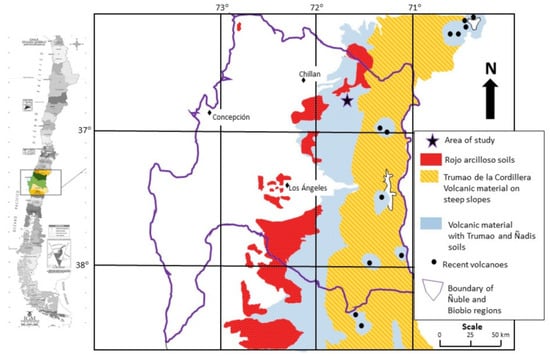
Figure 1.
Distribution of the different volcanic soils in the Ñuble and Biobio regions and the location of the area of study. (Modified after [26]).
The sampling area is located in the region of Ñuble, 35 km to the southeast of Chillán (Figure 1). The location has the geographic coordinates of 36°47′26.85″ S; 71°46′52.37″ W, and an altitude of 520 m above sea level.
The samples were extracted from an exposed slope along a road cut of a forestry road near route N-55 (close to the town of Recinto). Within the road cut, three soil horizons of Trumao could be distinguished (Figure 2): H1, corresponding to the upper-most surface layer, with a large amount of roots and organic material, and a high grade of weathering; H2, Trumao, with a high grade of weathering, a lesser amount of roots and organic material and the characteristic that it disintegrates on contact. H3, Trumao, with a lower grade of weathering, little or no presence of roots, high moisture content and cohesive behavior. Table 1 summarizes the different soil horizons with their on-site description.
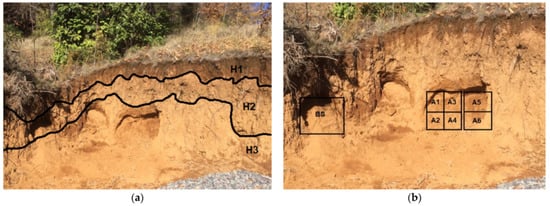
Figure 2.
Roadside cut where the Trumao samples were extracted for the laboratory studies; (a) soil horizons are defined based on weathering, (b) location where the sample blocks were collected.

Table 1.
On-site geotechnical description of the horizons.
The sampling was carried out during two different field campaigns, where several undisturbed block samples were collected (Figure 2b). The samples were isolated with several layers of plastic film to reduce moisture change during transportation and storage. In addition, the surface layer of each block was removed before testing to ensure that the samples were not influenced by drying.
2.2. Sample Description
The present work aims to compare the geotechnical behavior of weathered volcanic ash soils tested in the laboratory under two different conditions: an undisturbed state and an oven-dried state. The undisturbed state corresponds to those samples that do not present any type of alteration or disturbance, especially avoiding moisture changes. They were extracted directly from the sample blocks, removing the surface layer, and tested promptly. The oven-dried state corresponds to samples that were oven-dried at 110 °C for at least 24 h and then rehydrated for at least 12 h to achieve the original moisture and natural unit weight. All samples used in the present work focused on the H3 horizon.
2.3. Methods and Regulations
The American Society of Testing Material (ASTM) standards were followed for the laboratory determinations. The following tests were strictly performed as specified in the corresponding standard: specific gravity (ASTM D854), sieve analyses (ASTM D422 and ASTM D2217), one-dimensional consolidation (ASTM D 2435), unconfined compression (ASTM D 2166), and direct shear test (ASTM D3080). However, if the ASTM standard procedure required oven-drying of the undisturbed samples, the test procedures were adapted to avoid it. These modifications were made for the following tests: plasticity (ASTM D4318 and BS 1377-2), modified Proctor (ASTM D1557), and California Bearing Ratio (CBR) (ASTM D1883). Any changes made have been clearly indicated in this document.
2.3.1. Particle Size Distribution
Particle size analyses were carried out using the following procedures: for the dry samples, the test was conducted per ASTM D422 standard, while procedure B of the ASTM D2217 standard was used for the wet samples. Procedure B proposed was performed for particles passing the No. 10 sieve (2.00 mm openings) without washing. In this case, the size analyses were done to maintain the in-situ moisture. The moisture content of the size analyses was determined with an extra sample that was dried in the oven for at least 24 h.
2.3.2. Plasticity
The plasticity behavior tests were performed per ASTM D4318 (Casagrande apparatus method) and BS 1377-2 (fall cone apparatus method) to both the undisturbed and oven-dried soil samples, with a slightly different preparation process depending on sample type as the abovementioned standards require drying the samples prior to performing the tests. Usually, the material is dried in an oven at 110 °C for at least 24 h. However, the preparation procedure for both liquid and plastic determinations for the undisturbed samples were modified to avoid exposing the material to high temperatures. First, to the material with its natural moisture, sufficient water was added to the undisturbed material to achieve a moisture percentage close to the required (liquid or plastic limit). This moisturizing process lasted for at least 24 h for all undisturbed specimens. Afterwards, the procedure carried out was identical to that indicated in the corresponding standard. The oven-dried samples were dried at 110 °C (without passing through the No. 40 sieve) and moistened 24 h before the test, following the standard procedure.
2.3.3. Specific Gravity
The specific gravity was determined following the ASTM D854 standard, using procedures A and B for undisturbed and oven-dried samples, respectively. Both procedures propose the water pycnometer method. The principal difference between the two procedures is the preparation of the initial sample. Procedure A uses the material with its original moisture content, while procedure B requires oven-drying the samples before testing. Nevertheless, the results obtained were compared and resulted similar.
2.3.4. Modified Proctor
The modified Proctor (ASTM D1557) studies the variation of the dry density applying an equal amount of compaction energy to each sample, changing the moisture content of the material. In this study, tests were carried out considering the following variations in the procedure. For the modified Proctor test of the undisturbed state samples, during the preparation of the samples and in order to avoid the effect of drying of the sample which may alter the result of the test, instead of drying the sample and adding the amount of water necessary to obtain the different moisture contents required, the test started with a sample with its natural moisture content. The samples for the rest of the points were obtained adding water to the samples. Therefore, the point of lowest moisture corresponds to the natural moisture content. On the other hand, in the oven-dried state, there were no deviations from the procedure. The results obtained in this work were also compared with those obtained by other researchers.
2.3.5. California Bearing Ratio (CBR)
In the California Bearing Ratio test (CBR), the procedure outlined by the ASTM D1883 standard was used, with the following modifications. For the undisturbed state samples, CBR tests were carried out at the optimum moisture content obtained from the modified Proctor test. The amount of moist mass required to perform a CBR test was 45 kg, according to ASTM D1883 and ASTM D698. An uncompacted and undisturbed sample with a high moisture content was collected to carry out this test. The material was spread out in a closed environment under shadow conditions to slowly reduce its moisture content. Daily moisture content determinations were performed to carry out different moisture contents versus dry unit weight determinations close to the optimum. In the oven-dried state, there are no variations, and the ASTM D1883 standard procedure was followed as is.
2.3.6. Compressibility
Oedometer tests were performed to determine the deformation properties according to ASTM D 2435. To determine the influence of exposing the material to high temperatures, unaltered specimens carved directly from the blocks collected on site and specimens prepared using material dried in the oven at 110 °C until constant mass were tested. Oven-dried specimens were prepared to match the on-site characteristics, in terms of dry-unit weight and moisture content. The results from both types of samples were compared.
2.3.7. Undrained Shear Strength
Unconfined compression tests were performed per ASTM D2166 standard to determine the undrained shear strength. Undisturbed samples were obtained carving specimens from blocks collected from the sampling area. The material for the oven-dried specimens was dried in the oven for at least 24 h before specimen preparation. The specimens were prepared with the same in situ conditions, such as water content and unit weight.
2.3.8. Drained Shear Strength
The drained strength was studied by performing direct shear tests, following the ASTM D3080 standard. For the undisturbed samples, the test specimens were directly carved from blocks extracted from the sampling site. Some changes were applied to the procedure to test the influence of subjecting the material to high temperatures in its drained shear strength. The sample was first dried to a constant mass at 110 °C. Afterwards, water was added to match the moisture content of the undisturbed samples. Direct shear specimens were prepared in the shear box in three layers by tampering until the target unit weight was reached on each layer. The water content of the specimens was checked before the test, and specimens with significant differences were discarded. After specimen preparation, the test was carried out following the procedures described in ASTM D3080.
3. Results and Discussion
3.1. Particle Size Distribution
No significant differences were found comparing sieve results performed by dry or wet procedures. For both procedures, the material that passed the No. 200 sieve (0.076 mm openings) was 89% and 87%, for the dry and wet method, respectively. Despite the similar results obtained, based on practical experience, it is recommended to use the wet method to determine the fine fraction. It should be noted that the dried fine particles tend to agglomerate, complicating the separation process, and thus extending the washing time for several hours.
3.2. Atterberg Limits
Two methods were used to study the liquid limit of the material: the Casagrande method (ASTM D4318) and the fall cone method (BS 1377-2). Figure 3 shows the results obtained with the Casagrande method. A total of nine determinations with different moisture contents were carried out in this investigation. The liquid limit determined with the Casagrande method on the undisturbed and oven-dried samples was 110% and 62%, respectively. For the cone fall method, several penetrations were applied to each sample for every moisture content, as indicated in BS 1377-2. The number of determinations used to determine the liquid limit of undisturbed and oven-dried samples with the cone fall test were 16 and 14, respectively. The moisture content was determined in three different stages for the undisturbed and four for the oven-dried samples. Figure 4a,b shows the results obtained in the cone fall tests for the undisturbed and oven-dried samples, respectively. The mean moisture content was plotted against the resulting penetration to obtain the liquid limit (Figure 5). The liquid limits determined with the cone fall test were 110% and 83% for the undisturbed and oven-dried samples, respectively.
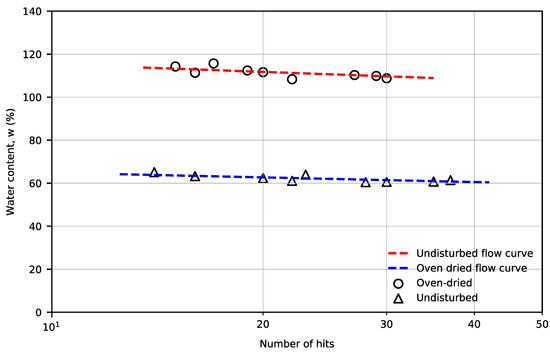
Figure 3.
Results obtained using the Casagrande method on undisturbed and oven-dried samples.
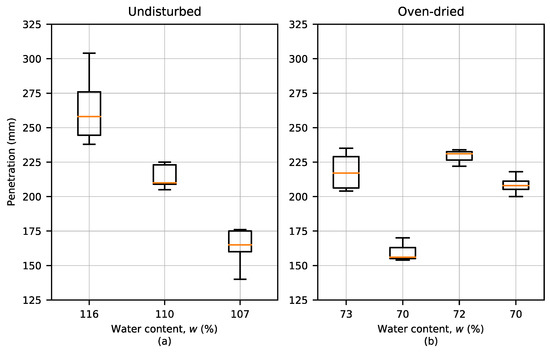
Figure 4.
Box plots representing the liquid limits with the cone fall test for (a) undisturbed and (b) oven-dried samples.
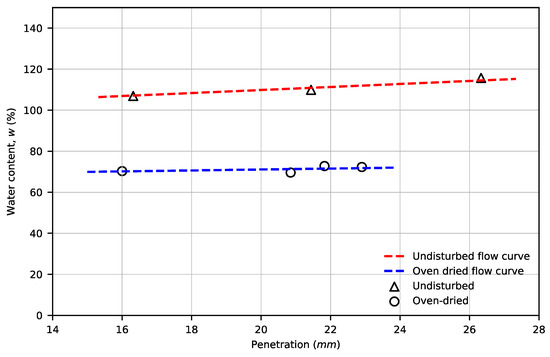
Figure 5.
Results obtained using the cone fall method on undisturbed and oven-dried samples.
The plastic limit was obtained for the undisturbed and oven-dried samples using three and five samples, respectively. Figure 6 shows the results of the plastic limit as a box plot representation. The mean plastic limit determined for the undisturbed samples was 80%, while the oven-dried was 58%.

Figure 6.
Results obtained using the cone fall method for undisturbed and oven-dried samples.
3.3. Soil Classification
The Unified Soil Classification System (USCS) was used for soil classification as described in ASTM D2487. The mean percentage of particles passing the sieve No. 200 (0.076 mm openings) was above 50%, and thus the classification was based on Casagrande’s plasticity chart. The results obtained in this work and others found in the literature for similar material [10,11,12,13,14,27,28] are summarized in Figure 7.
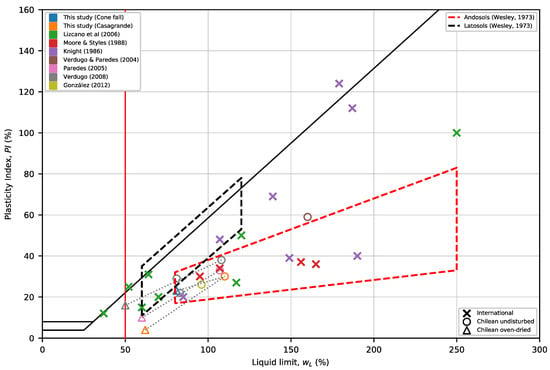
Figure 7.
Casagrande’s plasticity chart with data of different samples of residual soils derived from volcanic ash, with color representing the original study, marker shape the origin (international, Chilean undisturbed and Chilean oven-dried). Areas determined in [15] for andosols and latosols are represented with dashed line boxes.
Wesley [15] studied volcanic clays located in Java (Indonesia) and determined areas on Casagrande’s chart where andosols and latosols can be found. These soils are mainly composed of allophane and halloysite, respectively. The areas mentioned can be seen in Figure 7 with the black dashed line representing latosols and the red area andosols.
The undisturbed and oven-dried results obtained applying the Casagrande and cone fall methods are shown in Figure 8 in orange and blue, respectively. The allophanic soil samples tested in the undisturbed and oven-dried samples were both classified as MH based on ASTM D2487. With these results, the material could be classified as andosols [15]. The results from the classification and description provided for andosols match the characteristics of the soils studied in this investigation. The liquid and plastic limits determined in the oven-dried samples decrease by approximately 45% and 20% compared to the undisturbed samples. Allophane and imogolite are fine particles that contribute to the plastic behavior. The plasticity reduction between the undisturbed and oven-dried samples can be seen as grey dotted lines in Figure 7.
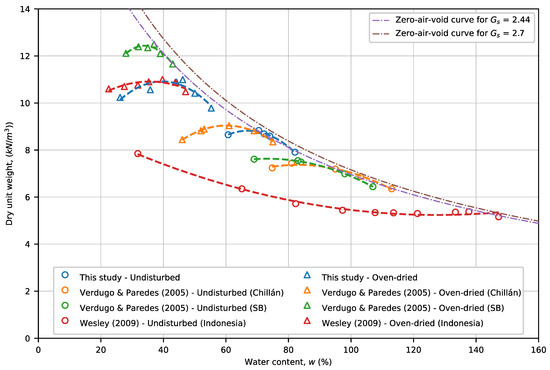
Figure 8.
Compaction curves of undisturbed and oven-dried soils, zero-air-void curves with GS = 2.7 and GS = 2.44.
3.4. Specific Gravity
The specific gravity of the solids () determined for the undisturbed and oven-dried samples are 2.49 and 2.44, respectively. As noted above, the specific gravity performed on the undisturbed samples was performed following procedure B of ASTM D854.
Varela [6] determined the specific gravity of allophanic soils using procedures A and B of ASTM D854 with variations in room temperature. The author recommends determining the specific gravity using both procedures, A and B, of the standard. Several Chilean researchers determined the specific gravity of different soils derived from volcanic ash, with values ranging between 2.71 and 2.77 [6,10,11].
3.5. Modified Proctor
Figure 8 shows the modified Proctor compaction curves obtained in this study and others for allophanic soils reported in the literature. The maximum dry density () determined in this investigation for the undisturbed samples was 9.76 kN/m3 with an optimum moisture content () of 64%. Therefore, it must be noted that the maximum dry density achieves a value slightly lower than the water unit weight (). On the other hand, for oven-dried samples, a value of 10.95 kN/m3 for the maximum dry density is achieved, with an optimum moisture content of 46%.
The maximum dry density and the optimum moisture content obtained on undisturbed and oven-dried allophanic soils samples are significantly different. Similar results were observed by other researchers [9,13]. The optimum moisture obtained in oven-dried samples ranges from 35 to 60%, while in the undisturbed samples it is between 70 and 140% (Figure 8). In contrast, the maximum dry density is higher in oven-dried (: 9 to 12 kN/m3) than in undisturbed samples (: 5 to 9 kN/m3). Some Proctor curves found in the literature cannot be used to determine the compaction characteristics as they do not have a clear maximum or they do not even show a relationship between dry unit weight after compaction and soil water content. For this reason, in this study, these curves were not analyzed, and thus their results are not included in this investigation. One of these curves can be seen in Figure 8, corresponding with oven-dried material from Indonesia [9]. The author suggests using a different compaction control method for those materials, based mainly in strength rather than in compaction itself.
The zero-air-void curve is a function of the dry density, moisture content, and the specific gravity of the soils. Figure 8 shows two zero-void-curves for allophanic soils for different specific gravity values: (I) a mean specific gravity of soils obtained in this work (), and (II) a value determined by Verdugo [12] (). In general, the wet side of the Proctor curve in undisturbed allophanic samples is very close to the zero-air-void curve.
3.6. California Bearing Ratio (CBR)
California Bearing Ratio (CBR) tests were carried out to complement the Proctor test results. Figure 9a,b shows the stress applied of each specimen against the penetration of the undisturbed and oven-dried samples, respectively. For example, in the specimen prepared applying 56 hits per layer, the dry unit weight obtained for the undisturbed samples is equal to 9.1 kN/m3, whereas for oven-dried samples it is equal to 10.7 kN/m3. The CBR is determined at the penetration of 5.08 mm for both samples, with a value of 15.4 and 29.4%, for the undisturbed and oven-dried samples, respectively. Therefore, the CBR at 5.08 mm of penetration determined in the oven-dried specimen doubles the one obtained for the undisturbed samples. Thus, commercial laboratories should not dry allophanic soil samples in the oven to measure the CBR due to significant changes in their results. This is especially relevant as the obtained values for oven-dried samples are significantly higher, leading to unsafe designs. For example, for AASHTO technical standards, a CBR equal to 100 for the granular base layer and about 30 for the granular subbase is required. According to this standard, the oven-dried allophanic soil could be used as subbase material in pavement construction with a CBR of 29.4%, while the same soil in undisturbed conditions (with a CBR of 15.4%) could only be used as a subgrade. The variation of the CBR with the dry specific weight for both samples is presented in Figure 9c. The behavior of an intermediate state has not been evaluated in this work, such as drying in the air or under the shade.
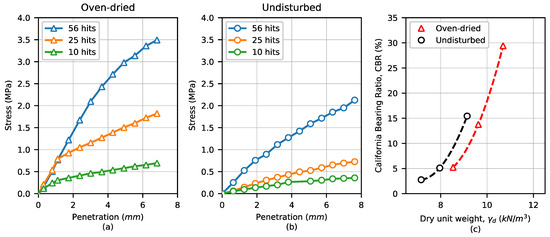
Figure 9.
CBR test results. (a) stress against penetration for oven-dried samples, (b) stress against penetration for undisturbed samples, and (c) California Bearing Ratio against dry unit weight for both samples.
3.7. Compressibility
The behavior of sedimentary and residual soils differs in several aspects, and this difference can usually be observed analyzing the void ratio-pressure plots both as linear and semi-logarithmic representations [29]. Furthermore, in sedimentary soils, the preconsolidation pressure determines the reaction of the soil to a variation of stress, whereas vertical yield pressure governs the behavior of residual soils. Both the significance and the physical meaning of these two stresses are different. The preconsolidation pressure can be modified by partial soil erosion over time after deposition or by height variation of the water table. An increase in the vertical effective stress caused by either reason generates the compression of the soil and the increase in its constrained modulus. In contrast, the yield stress is related significantly to the rock’s weathering in a geological context rather than the depth where the samples were collected [30]. For this reason, consolidation is usually not studied in the same way in residual and sedimentary soils. Although in both cases the void ratio-pressure plot is analyzed, for sedimentary soils it is typically represented with the effective pressure axis in a logarithmic scale, whereas for residual soils, a linear scale is used.
Three undisturbed and three oven-dried specimens, all 50 mm in diameter, were tested in the oedometer for this investigation. The oedometer curves obtained in the testing campaign for undisturbed and oven-dried samples in a linear form are shown in Figure 10a,b, respectively, while Figure 10c,d shows them in log form.
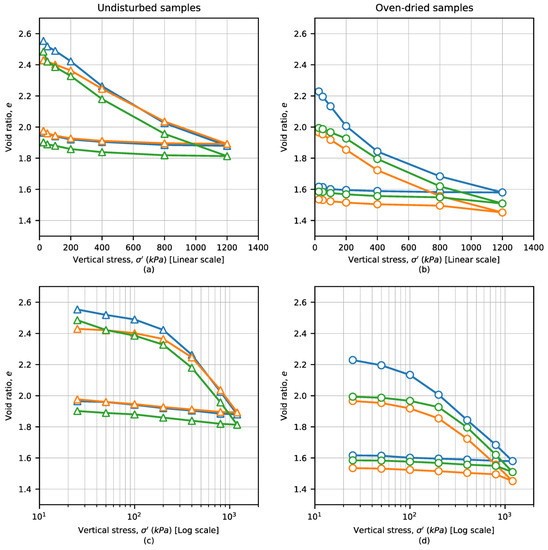
Figure 10.
Odometer test results: (a) undisturbed samples in linear form, (b) oven-dried samples in linear form, (c) undisturbed samples in vertical effective stress logarithmic form, (d) oven-dried samples in logarithmic form.
The results plotted in a linear form do not show a clear and pronounced gradient change at a particular stress level, as reported in the literature [29]. The analyses of the traditional void ratio against vertical effective pressure in log scale show a preconsolidation pressure between 200 and 300 kPa (Figure 10c,d). Oven-dried specimens show vertical yield stress that depends on the energy used to remold the sample rather than a natural preconsolidation pressure.
Independent of the logarithmic or linear form of analyses, the initial void ratios determined in undisturbed samples were between 2.57 and 2.44 (Figure 10c), while the oven-dried samples were in the range between 2.25 and 1.97 (Figure 10d). Therefore, the initial void ratio of undisturbed samples can be considered high in comparison with most sedimentary soils.
For foundations supported in residual soils, it is recommended to assess the consolidation settlement with the coefficient of compressibility (mv) instead of compression (Cc) and swell (Cs) indexes [29]. The mean coefficient of compressibility determined for undisturbed samples within the vertical effective stress range of 25–400 kPa was 6.42·10−3 kPa−1, whereas for oven-dried specimens in the same effective vertical stress, an average mv of 9.7·10−3 kPa−1 was obtained. The compressibility coefficient determined on residual soils and allophanic soils reported in the literature and performed within the same stress range as in this research range from 6·10−3 and 2.5·10−4 kPa−1 [29].
In oedometer tests, a minimum number of settlement readings per loading pressure are required to determine an accurate coefficient of consolidation (cv). If the number of readings in the straight part of the curve is less than three, the coefficient of consolidation is inaccurate. Wesley [29,31] indicated that the coefficient of consolidation of undisturbed allophanic soils obtained in an oedometer apparatus are unreliable for low pressures (25 to 1000 kPa). Values of the coefficient of consolidation above 0.1 m2/day are inconsistent with the oedometer test due to the excessive rapid velocity of reducing the water pore pressure induced by the vertical stress increment [29,32].
Figure 11a,b shows the variations of the settlement percentage with the square root of time (Taylor’s procedure) at 25 to 50, 100 to 200, and 800 to 1.200 kPa increments for undisturbed and oven-dried allophanic soil samples tested. None of the curves shown in Figure 11 can be used to determine an accurate value of the coefficient of consolidation.
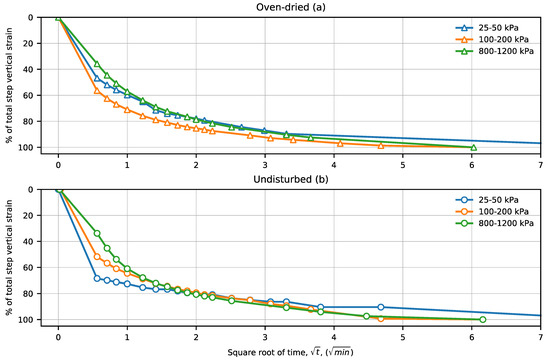
Figure 11.
Variations of the settlement’s percentages with the square root of time (Taylor procedure) (a) undisturbed (b) oven-dried.
The oedometric results obtained in this work for the undisturbed samples were similar to data found in the literature for the same kind of material [29,31]. However, the oven-dried results do not show a regular pattern of evolution of their results. Wesley [31] recommended performing the dissipation of the pore pressure on a triaxial cell instead of oedometric tests to study the coefficient of consolidation of allophanic soils.
3.8. Undrained Shear Strenght
Cylindrical specimens with a diameter of 50 mm and a height of 100 mm were tested in the laboratory to obtain the undrained shear strength of the material. A total of 18 samples were tested, 9 for the undisturbed state and 9 subjected to oven-drying. Figure 12 shows a box plot of the obtained results for both states.
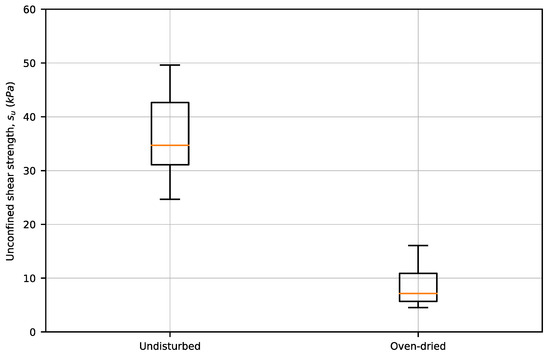
Figure 12.
Box plots of Unconfined Compression Tests for undisturbed and oven-dried samples.
On average, an undrained shear strength of 36.3 kPa was obtained for the undisturbed samples, whereas in the oven-dried samples, a value of 8.8 kPa was obtained. Standard deviation was 7.94 and 3.87 kPa for undisturbed and oven-dried samples respectively. With this data, the sensitivity to remolding of the material can be obtained using Equation (1).
The sensitivity value corresponds to 4.15, and thus would classify the samples as very sensitive soil [33]. Some authors obtained a sensitivity equal to 13 [13], 3 [12], and even a value of 42 is reported [10]. The scatter of the reported data for the sensitivity to remolding of the material, depending on the place of sample extraction, indicates the need for a site-specific characterization of the material. However, a trend in the behavior can be extracted, with all reported samples being classified at least as sensitive.
3.9. Drained Shear Strenght
Consolidated drained direct shear tests were used to evaluate the drained shear strength of the material and the influence of oven drying on it. Twelve specimens with different normal stress were tested for the undisturbed state whereas four were tested for the oven-dried state. For the undisturbed samples, eight circular (60 mm in diameter, represented with dashed lines in Figure 13) and four square (100 mm sides) represented with solid lines in Figure 13) specimens were tested. For the oven dried sample, four specimens were tested, all using a 100 mm square box. Results are shown in Figure 13.
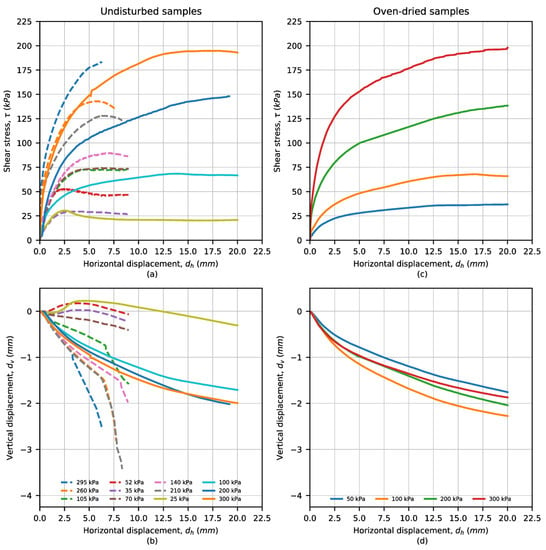
Figure 13.
Direct shear test results (a) Shear stress against shear displacement for undisturbed specimens. (b) Vertical displacement against shear displacement for undisturbed specimens. (c) Shear stress against shear displacement for oven-dried specimens. (d) Vertical displacement against shear displacement for oven-dried specimens.
For the undisturbed state, specimens with a normal stress lower than 52 kPa behave as over consolidated, while for higher stresses, a normally consolidated behavior is observed. However, for oven-dried samples, the specimen with a normal stress of 50 kPa behaves as normally consolidated and show neither peak resistance nor increase in volume. This could be an effect of dynamic compaction.
To study the drained shear strength of the material, the Mohr–Coulomb criterion was used. Figure 14 shows the linear envelopes obtained for undisturbed (red line) and oven-dried (blue line) samples.
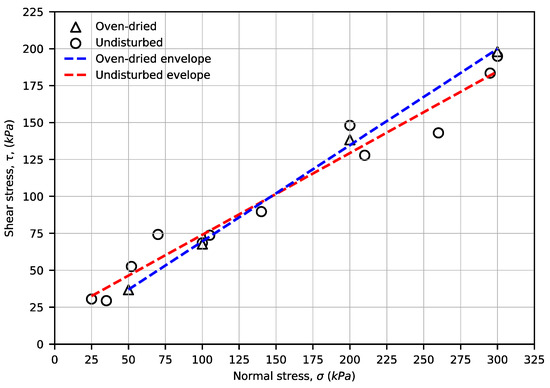
Figure 14.
Mohr plane representation of maximum shear stress state for each test specimen and liner Mohr-Coulomb envelopes.
A friction angle of 29° and 33° was obtained for the undisturbed and oven-dried samples, respectively. As for the cohesion, for undisturbed samples, a value of 18.7 kPa was obtained while the cohesion of oven-dried samples resulted to be 4.3 kPa. Both envelopes showed an acceptable fit with a coefficient of determination (R2) of 0.962 for undisturbed material and 0.999 for oven-dried material. As demonstrated in other test results, oven-drying the material produces a change in its behavior, with oven-dried specimens showing more sand-like behavior, while undisturbed samples behave as a more cohesive soil.
4. Summary and Conclusions
The geotechnical behavior of undisturbed and oven-dried allophanic soils was determined and compared using geotechnical laboratory test. Table 2 summarizes the obtained results for both states, along with the standard used in the testing procedures. The principal conclusions attained in the present work are summarized below:

Table 2.
Summary of results of the testing campaign.
- The plastic behavior soil moisture range was considerably reduced by oven-drying. Both undisturbed and oven-dried samples classify as MH using the Unified Soil Classification System, as described in the ASTM D2487 standard.
- Specific gravity tests were performed following procedures A and B described in the ASTM D 854 standard, with similar results for both methods. The mean specific gravity of particles determined were 2.44 and 2.49 for undisturbed and oven-dried samples, respectively. However, other authors have reported values close to 2.7 for the same type of soil [6,10,11].
- The maximum dry density obtained with the modified Proctor tests increases noticeably (12%) with oven-drying, and the optimum water content decreases (−28%)
- The Californian Bearing Ratio (CBR) obtained on undisturbed and oven-dried samples, determined at the penetration of 5.08 mm, is 15.4% and 29.4%, respectively. With these results, the material could be used as a subgrade or subbase, depending on material condition. Thus, commercial laboratories should not dry allophanic soil samples in the oven to measure the CBR due to significant changes in their results.
- The initial void ratio of undisturbed allophanic soils is considered high in comparison with most sedimentary soils. The mean coefficient of compressibility (mv) determined for undisturbed and oven-dried samples in the range between 40 and 200 kPa of vertical effective stress was obtained. In these conditions, the value of the coefficient of compressibility was 6.42·10−3 and 9.70·10−3 kPa−1 for the undisturbed and oven-dried samples, respectively. It was verified that the oedometer test could not determine adequately the value of the coefficient of consolidation (cv) in the usual foundations pressure range (40 to 200 kPa). The aforementioned is explained due to the small number of lectures in which the soil reduces the excess pore pressure in the typical vertical effective stress range used in the design of foundations.
- The sensitivity obtained was near 4, classified as very sensitive soil as proposed by Terzaghi et al. [33].
- A friction angle of 29° and 33° was obtained, while the cohesion was 18.7 kPa and 4.3 kPa, for undisturbed and oven-dried respectively. Minor changes were achieved between the undisturbed and the oven-dried samples considering Mohr–Coulomb failure criterion.
Based on the results, it is recommended performing geotechnical characterization of allophanic soils in the same conditions found in-situ and avoid drying samples during the tests when possible. If these cautions cannot be taken, the uncertainties of the change in behavior induced by testing conditions should be considered on subsequent analysis using the obtained parameters.
Author Contributions
Conceptualization, J.M.M.-C.; formal analysis, P.E.R.-M. and J.M.M.-C.; funding acquisition, J.M.M.-C. and R.W.K.; investigation, P.E.R.-M. and J.M.M.-C.; methodology, P.E.R.-M., J.M.M.-C. and P.L.-M.; project administration, P.E.R.-M. and J.M.M.-C.; resources, J.M.M.-C., R.W.K. and P.L.-M.; software, P.L.-M. and C.G.-C.; supervision, J.M.M.-C., R.W.K. and P.L.-M.; validation, J.M.M.-C., R.W.K., P.L.-M. and C.G.-C.; visualization, R.W.K., P.L.-M. and C.G.-C.; writing—original draft, P.E.R.-M.; writing—review and editing, J.M.M.-C., R.W.K., P.L.-M. and C.G.-C. All authors have read and agreed to the published version of the manuscript.
Funding
This research was funded by the Dirección de Investigación of the Universidad Católica de la Santísima Concepción, fund DIN 20/2016.
Institutional Review Board Statement
Not applicable.
Informed Consent Statement
Not applicable.
Data Availability Statement
The Jupyter notebook used for data analysis and figure development along with a spreadsheet file (.xlsx) containing all data is available at the following URL: https://github.com/plapenamanero/trumao_2021. The notebook is developed in Python and intended to be used in Google Colab.
Acknowledgments
The authors would like to thank the support and collaboration from the Geotechnical Group of the School of Construction of the Pontificia Universidad Católica de Valparaíso, Chile (PUCV), and specially to professors Juan Palma and Pamela Valenzuela. The authors are also grateful to Geotecnia Ambiental (Valparaíso, Chile) for their support and lending in situ equipment to perform tests for this project. The authors would also like to acknowledge the postgraduate program of the Faculty of Engineering and University during the studies of Pablo Eduardo Romero-Mancilla.
Conflicts of Interest
The authors declare no conflict of interest.
References
- Besoain, E. Génesis y transformación de los minerales de arcilla en suelos derivados de cenizas volcánicas del Centro—Sur de Chile. In Suelos Volcánicos de Chile; INIA: Spring Hill, TN, USA, 1985; p. 723. [Google Scholar]
- Schlatter, J.E.; Grez, R.; Gerding, V. Manual Para el Reconocimiento de Suelos; Universidad Autral de Chile: Valdivia, Chile, 2003; ISBN 956-7105-25-1. [Google Scholar]
- Veblen, T.T. Temperate Forests of the Southern Andean Region. In Temperate Forests of the Southern Andean Region; Oxford University Press: Oxford, UK, 2007. [Google Scholar]
- Börgel Olivares, R. Geomorfología; Geografía de Chile; Instituto Geográfico Militar: Santiago, Chile, 1983. [Google Scholar]
- Wright, C.A. The Volcanic Ash Soils of Chile; Expanded program of technical assistance; Food and Agricultute Organization of The United Nations (FAO): Rome, Italy, 1965. [Google Scholar]
- Varela Cunazza, F.A. Efecto del Tipo de Secado en Las Propiedades Índice y Compresibilidad de Suelos de Origen Volcánico. Bachelor’s Thesis, Universidad de Chile, Santiago, Chile, 2016. [Google Scholar]
- Sanhueza, C.; Palma, J.; Valenzuela, P.; Araneda, O.; Calderón, K. Evaluación del comportamiento geotécnico de suelos volcánicos chilenos para su uso como material de filtro en la depuración de aguas residuales domésticas. Rev. Constr. 2011, 10, 66–81. [Google Scholar] [CrossRef][Green Version]
- Schlatter, J.E.; Romeny, G.; Madariaga, S. Capacidad de filtro de los suelos del sur de chile a la aplicación de lodos de piscicultura. Agro Sur 2020, 48, 41–59. [Google Scholar] [CrossRef]
- Wesley, L. Behaviour and geotechnical properties of residual soils and allophane clays. Obras Proy. 2009, 6, 5–10. [Google Scholar]
- González Pulgar, C.A. Propiedades Geomecánicas de Dos Suelos de Origen Volcánico. Master’s Thesis, Universidad de Chile, Santiago, Chile, 2012. [Google Scholar]
- Paredes, M. Geotecnia de Suelos Derivados de Ceniza Volcánica. Master’s Thesis, Universidad de Chile, Santiago, Chile, 2005. [Google Scholar]
- Verdugo, R. Singularities of Geotechnical Properties of Complex Soils in Seismic Regions. J. Geotech. Geoenviron. Eng. 2008, 134, 982–991. [Google Scholar] [CrossRef]
- Verdugo, R.; Paredes, M. Comportamiento Geomecánico de Suelos Alofánicos; V Congreso Chileno de Ingeniería Geotécnica: Santiago, Chile, 2004; p. 10. [Google Scholar]
- Lizcano, A.; Herrera, M.C.; Santamarina, J.C. Suelos derivados de cenizas volcánicas en Colombia. Rev. Int. Desastres Nat. Accid. E Infraestruct. Civ. 2006, 6, 167–198. [Google Scholar]
- Wesley, L.D. Some basic engineering properties of halloysite and allophane clays in Java, Indonesia. Géotechnique 1973, 23, 471–494. [Google Scholar] [CrossRef]
- Yuan, G.; Wada, S. Allophane and Imogolite Nanoparticles in Soil and Their Environmental Applications. In Nature’s Nanostructures; Barnard, A., Guo, H., Eds.; CRC Press: Boca Raton, FL, USA, 2012; p. 516. ISBN 978-981-4364-21-8. [Google Scholar]
- Huang, Y.; Lowe, D.; Churchman, G.; Schipper, L.; Cursons, R.; Zhang, H.; Chen, T.; Cooper, A. DNA adsorption by nanocrystalline allophane spherules and nanoaggregates, and implications for carbon sequestration in Andisols. Appl. Clay Sci. 2016, 120, 40–50. [Google Scholar] [CrossRef]
- Parfitt, R.L. Allophane in New-Zealand. Aust. J. Soil Res. 1990, 28, 343–360. [Google Scholar] [CrossRef]
- Wada, S. Imogolite synthesis at 25 °C. Clays Clay Miner. 1987, 35, 379–384. [Google Scholar] [CrossRef]
- Bottero, I.; Bonelli, B.; Ashbrook, S.; Wright, P.; Zhou, W.; Tagliabue, M.; Armandi, M.; Garrone, E. Synthesis and characterization of hybrid organic/inorganic nanotubes of the imogolite type and their behaviour towards methane adsorption. Phys. Chem. Chem. Phys. 2011, 13, 744–750. [Google Scholar] [CrossRef] [PubMed]
- Wada, K. Chapter 4 Allophane and imogolite. In Developments in Sedimentology; Sudo, T., Shimoda, S., Eds.; Elsevier: Amsterdam, The Netherlands, 1989; Volume 26, pp. 147–187. ISBN 0070-4571. [Google Scholar]
- Parfitt, R. Allophane and imogolite: Role in soil biogeochemical processes. Clay Miner. 2009, 44, 135–155. [Google Scholar] [CrossRef]
- Henmi, T.; Wada, K. Morphology and composition of allophane. Am. Mineral. 1976, 61, 379–390. [Google Scholar]
- Jongmans, A.G.; Denaix, L.; van Oort, F.; Nieuwenhuyse, A. Induration of C Horizons by Allophane and Imogolite in Costa Rican Volcanic Soils. Soil Sci. Soc. Am. J. 2000, 64, 254–262. [Google Scholar] [CrossRef]
- Paredes, M.; Verdugo, R. Génesis y Estructura de Los Suelos Alofánicos en Chile; Universidad de Chile: Santiago, Chile, 2004; p. 10. [Google Scholar]
- Gajardo, A. Hojas Concepción-Chillán, Región del Bío-Bío; Mapas Geológicos Preliminares de Chile; Instituto de Investigaciones Geológicas: Santiago, Chile, 1981. [Google Scholar]
- Knight, D.J. Geotechnical properties and behaviour of the Monasavu halloysite clay, Fiji. Clay Miner. 1986, 21, 311–332. [Google Scholar] [CrossRef]
- Moore, P.J.; Styles, J.R. Some characteristics of a volcanic ash soil. In Proceedings of the Geomechanics in Tropical Soils, Singapore, 12–14 December 1988. [Google Scholar]
- Wesley, L.D. Fundamentals of Soil Mechanics for Sedimentary and Residual Soils; Wiley: New York, NY, USA, 2010; ISBN 978-0-470-37626-3. [Google Scholar]
- Sidebottom, C. Mechanics of Residual Soils, 2nd ed.; Blight, G.E., Leong, E.C., Eds.; CRC Press: London, UK, 2012; ISBN 978-0-429-21702-9. [Google Scholar]
- Wesley, L.D. Consolidation behaviour of allophane clays. Géotechnique 2001, 10, 901–904. [Google Scholar] [CrossRef]
- Wesley, L.D. Residual Soils—With Special Reference to Allophane Clays; V Congreso Chileno de Ingeniería Geotécnica: Santiago, Chile, 2004. [Google Scholar]
- Terzaghi, K.; Peck, R.B.; Mesri, G. Soil Mechanics in Engineering Practice, 3rd ed.; Wiley-Interscience: Hoboken, NJ, USA, 1996; ISBN 0-471-08658-4. [Google Scholar]
Publisher’s Note: MDPI stays neutral with regard to jurisdictional claims in published maps and institutional affiliations. |
© 2021 by the authors. Licensee MDPI, Basel, Switzerland. This article is an open access article distributed under the terms and conditions of the Creative Commons Attribution (CC BY) license (https://creativecommons.org/licenses/by/4.0/).